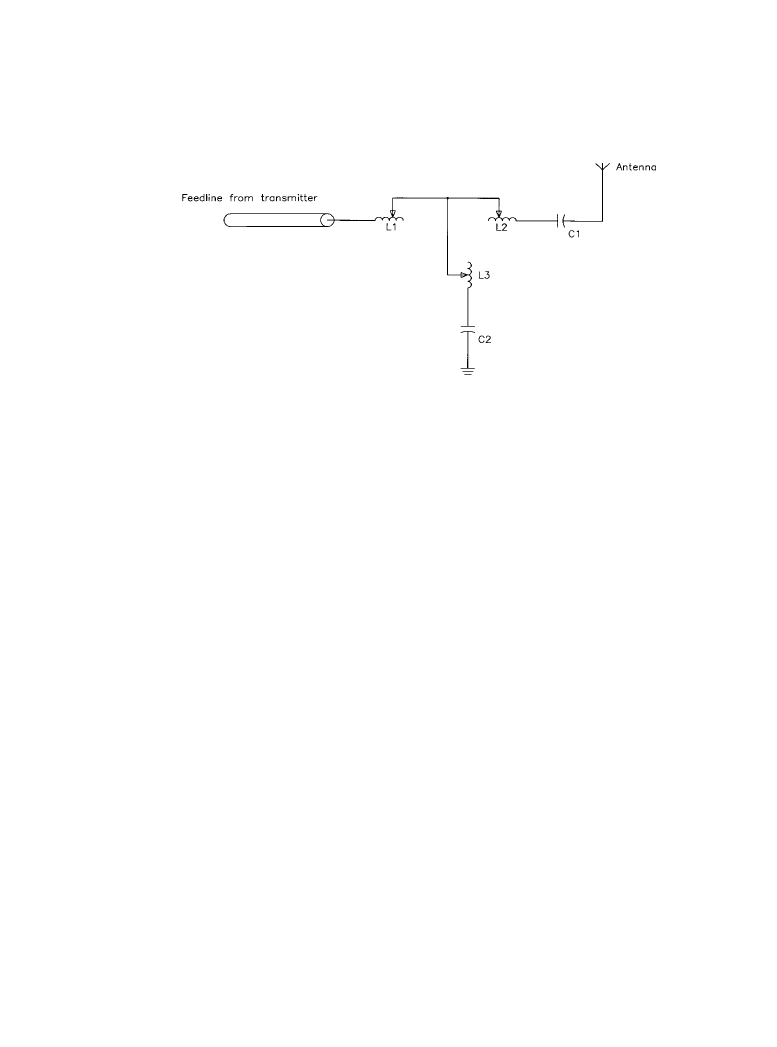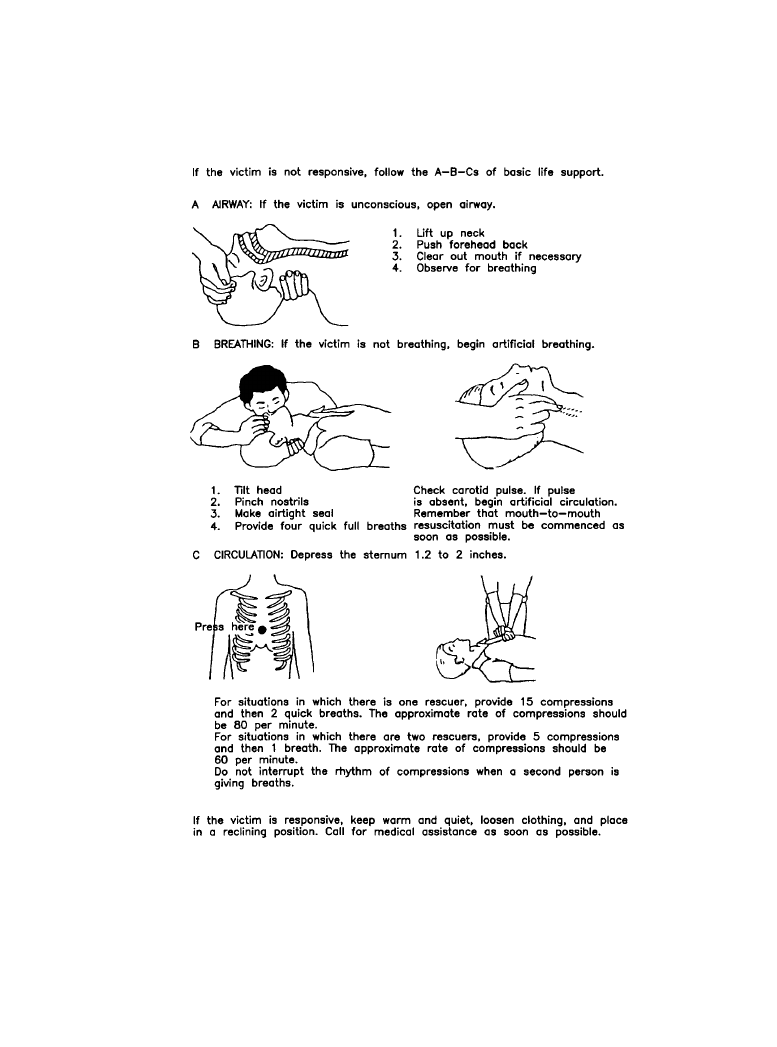ВУЗ: Казахская Национальная Академия Искусств им. Т. Жургенова
Категория: Книга
Дисциплина: Не указана
Добавлен: 03.02.2019
Просмотров: 21579
Скачиваний: 19

13-42 Standards and Practices
RF Considerations
Engineers often rely on electrical gloves when making adjustments to live RF circuits. This prac-
tice, however, can be extremely dangerous. Consider the typical load matching unit shown in
Figure 13.3.4. In this configuration, disconnecting the coil from either L2 or L3 places the full
RF output literally at the engineer’s fingertips. Depending on the impedances involved, the volt-
ages can become quite high, even in a circuit that normally is relatively tame.
In the Figure 13.3.4 example, assume that the load impedance is approximately 106 +j202
Ω.
With 1 kW feeding into the load, the rms voltage at the matching output will be approximately
700 V. The peak voltage (which determines insulating requirements) will be close to 1 kV, and
perhaps more than twice that if the carrier is being amplitude-modulated. At the instant the out-
put coil clip is disconnected, the current in the shunt leg will increase rapidly, and the voltage
easily could more than double.
13.3.2d
First Aid Procedures
All engineers working around high-voltage equipment should be familiar with first aid treatment
for electric shock and burns. Always keep a first aid kit on hand at the facility. Figure 13.3.5
illustrates the basic treatment for victims of electric shock. Copy the information, and post it in a
prominent location. Better yet, obtain more detailed information from the local heart association
or Red Cross chapter. Personalized instruction on first aid usually is available locally.
13.3.2e
Operating Hazards
A number of potential hazards exist in the operation and maintenance of high-power vacuum
tube RF equipment. Maintenance personnel must exercise extreme care around such hardware.
Consider the following guidelines:
Figure 13.3.4
Example of how high voltages can be generated in an RF load matching network.
Downloaded from Digital Engineering Library @ McGraw-Hill (www.digitalengineeringlibrary.com)
Copyright © 2004 The McGraw-Hill Companies. All rights reserved.
Any use is subject to the Terms of Use as given at the website.
Safety Issues

Safety Issues 13-43
Figure 13.3.5
Basic first aid treatment for electric shock.
Downloaded from Digital Engineering Library @ McGraw-Hill (www.digitalengineeringlibrary.com)
Copyright © 2004 The McGraw-Hill Companies. All rights reserved.
Any use is subject to the Terms of Use as given at the website.
Safety Issues

13-44 Standards and Practices
•
Use caution around the high-voltage stages of the equipment. Many power tubes operate at
voltages high enough to kill through electrocution. Always break the primary ac circuit of the
power supply, and discharge all high-voltage capacitors.
•
Minimize exposure to RF radiation. Do not permit personnel to be in the vicinity of open,
energized RF generating circuits, RF transmission systems (waveguides, cables, or connec-
tors), or energized antennas. High levels of radiation can result in severe bodily injury, includ-
ing blindness. Cardiac pacemakers may also be affected.
•
Avoid contact with beryllium oxide (BeO) ceramic dust and fumes. BeO ceramic material
may be used as a thermal link to carry heat from a tube to the heat sink. Do not perform any
operation on any BeO ceramic that might produce dust or fumes, such as grinding, grit blast-
ing, or acid cleaning. Beryllium oxide dust and fumes are highly toxic, and breathing them
can result in serious injury or death. BeO ceramics must be disposed of as prescribed by the
device manufacturer.
•
Avoid contact with hot surfaces within the equipment. The anode portion of many power
tubes is air-cooled. The external surface normally operates at a high temperature (up to
250°C). Other portions of the tube also may reach high temperatures, especially the cathode
insulator and the cathode/heater surfaces. All hot surfaces may remain hot for an extended
time after the tube is shut off. To prevent serious burns, avoid bodily contact with these sur-
faces during tube operation and for a reasonable cool-down period afterward. Table 13.3.3
lists basic first aid procedures for burns.
13.3.3 OSHA Safety Considerations
The U.S. government has taken a number of steps to help improve safety within the workplace
under the auspices of the Occupational Safety and Health Administration (OSHA). The agency
helps industries monitor and correct safety practices. OSHA has developed a number of guide-
lines designed to help prevent accidents. OSHA records show that electrical standards are among
the most frequently violated of all safety standards. Table 13.3.4 lists 16 of the most common
electrical violations, including exposure of live conductors, improperly labeled equipment, and
faulty grounding.
13.3.3a
Protective Covers
Exposure of live conductors is a common safety violation. All potentially dangerous electric con-
ductors should be covered with protective panels. The danger is that someone may come into
contact with the exposed current-carrying conductors. It is also possible for metallic objects such
as ladders, cable, or tools to contact a hazardous voltage, creating a life-threatening condition.
Open panels also present a fire hazard.
13.3.3b
Identification and Marking
Circuit breakers and switch panels should be properly identified and labeled. Labels on breakers
and equipment switches may be many years old and may no longer reflect the equipment actually
in use. This is a safety hazard. Casualties or unnecessary damage can be the result of an improp-
Downloaded from Digital Engineering Library @ McGraw-Hill (www.digitalengineeringlibrary.com)
Copyright © 2004 The McGraw-Hill Companies. All rights reserved.
Any use is subject to the Terms of Use as given at the website.
Safety Issues

Safety Issues 13-45
erly labeled circuit panel if no one who understands the system is available in an emergency. If a
number of devices are connected to a single disconnect switch or breaker, a diagram should be
provided for clarification. Label with brief phrases, and use clear, permanent, and legible mark-
ings.
Equipment marking is a closely related area of concern. This is not the same thing as equip-
ment identification. Marking equipment means labeling the equipment breaker panels and ac
disconnect switches according to device rating. Breaker boxes should contain a nameplate show-
ing the manufacturer, rating, and other pertinent electrical factors. The intent is to prevent
devices from being subjected to excessive loads or voltages.
13.3.3c
Grounding
OSHA regulations describe two types of grounding: system grounding and equipment grounding.
System grounding actually connects one of the current-carrying conductors (such as the termi-
nals of a supply transformer) to ground. (See Figure 13.3.6.) Equipment grounding connects all
of the noncurrent-carrying metal surfaces together and to ground. From a grounding standpoint,
the only difference between a grounded electrical system and an ungrounded electrical system is
that the main bonding jumper from the service equipment ground to a current-carrying conduc-
tor is omitted in the ungrounded system. The system ground performs two tasks:
•
It provides the final connection from equipment-grounding conductors to the grounded cir-
cuit conductor, thus completing the ground-fault loop.
Table 13.3.3 Basic First Aid Procedures for Burns
(More detailed information can be obtained
from any Red Cross office.)
Extensively Burned and Broken Skin
✓
Cover affected area with a clean sheet or cloth.
✓
Do not break blisters, remove tissue, remove adhered particles of clothing, or apply any salve or ointment.
✓
Treat victim for shock as required.
✓
Arrange for transportation to a hospital as quickly as possible.
✓
If arms or legs are affected, keep them elevated.
✓
If medical help will not be available within an hour and the victim is conscious and not vomiting, prepare a weak
solution of salt and soda: 1 level teaspoon of salt and level teaspoon of baking soda to each quart of tepid
water. Allow the victim to sip slowly about 4 ounces (half a glass) over a period of 15 minutes. Discontinue fluid
intake if vomiting occurs. (Do not offer alcohol.)
Less Severe Burns (First and Second Degree)
✓
Apply cool (not ice-cold) compresses using the cleanest available cloth article.
✓
Do not break blisters, remove tissue, remove adhered particles of clothing, or apply salve or ointment.
✓
Apply clean, dry dressing if necessary.
✓
Treat victim for shock as required.
✓
Arrange for transportation to a hospital as quickly as possible.
✓
If arms or legs are affected, keep them elevated.
Downloaded from Digital Engineering Library @ McGraw-Hill (www.digitalengineeringlibrary.com)
Copyright © 2004 The McGraw-Hill Companies. All rights reserved.
Any use is subject to the Terms of Use as given at the website.
Safety Issues

13-46 Standards and Practices
•
It solidly ties the electrical system and its enclosures to their surroundings (usually earth,
structural steel, and plumbing). This prevents voltages at any source from rising to harmfully
high voltage-to-ground levels.
Note that equipment grounding—bonding all electric equipment to ground—is required whether
or not the system is grounded. Equipment grounding serves two important tasks:
•
It bonds all surfaces together so that there can be no voltage difference among them.
•
It provides a ground-fault current path from a fault location back to the electrical source, so
that if a fault current develops, it will rise to a level high enough to operate the breaker or
fuse.
The National Electrical Code (NEC) is complex and contains numerous requirements con-
cerning electrical safety. The fact sheets listed in Table 13.3.4 are available from OSHA.
13.3.4 Beryllium Oxide Ceramics
Some tubes, both power grid and microwave, contain beryllium oxide (BeO) ceramics, typically
at the output waveguide window or around the cathode. Never perform any operations on BeO
Table 13.3.4 Sixteen Common OSHA Violations
(After [1]
.)
Fact Sheet
Subject
NEC
1
Refer-
ence
1
Guarding of live parts
110-17
2
Identification
110-22
3
Uses allowed for flexible cord
400-7
4
Prohibited uses of flexible cord
400-8
5
Pull at joints and terminals must be prevented
400-10
6.1
Effective grounding, Part 1
250-51
6.2
Effective grounding, Part 2
250-51
7
Grounding of fixed equipment, general
250-42
8
Grounding of fixed equipment, specific
250-43
9
Grounding of equipment connected by cord and plug
250-45
10
Methods of grounding, cord and plug-connected equipment
250-59
11
AC circuits and systems to be grounded
250-5
12
Location of overcurrent devices
240-24
13
Splices in flexible cords
400-9
14
Electrical connections
110-14
15
Marking equipment
110-21
16
Working clearances about electric equipment
110-16
1
National Electrical Code
Downloaded from Digital Engineering Library @ McGraw-Hill (www.digitalengineeringlibrary.com)
Copyright © 2004 The McGraw-Hill Companies. All rights reserved.
Any use is subject to the Terms of Use as given at the website.
Safety Issues